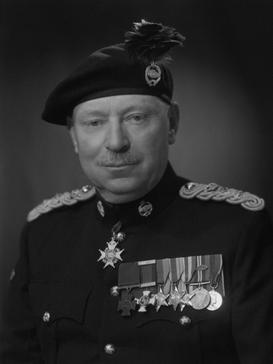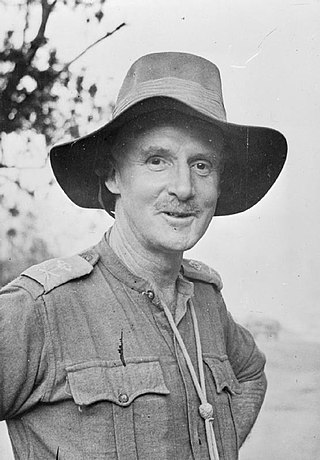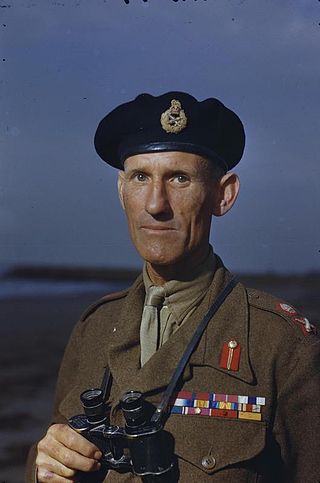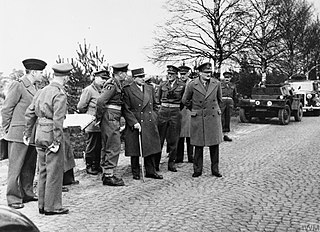Related Research Articles

I Corps was an army corps in existence as an active formation in the British Army for most of the 80 years from its creation in the First World War until the end of the Cold War, longer than any other corps. It had a short-lived precursor during the Waterloo Campaign. It served as the operational component of the British Army of the Rhine during the Cold War, and was tasked with defending West Germany.

Operation Sonnenblume was the name given to the dispatch of German and Italian troops to North Africa in February 1941, during the Second World War. The Italian 10th Army had been destroyed by the British, Commonwealth, Empire and Allied Western Desert Force attacks during Operation Compass (9 December 1940 – 9 February 1941). The first units of the new Deutsches Afrikakorps (DAK), commanded by Generalleutnant Erwin Rommel, departed Naples for Africa and arrived on 11 February 1941. On 14 February, advanced units of the 5th Light Afrika Division, Aufklärungsbataillon 3 and Panzerjägerabteilung 39 arrived at the Libyan port of Tripoli and were sent immediately to the front line east of Sirte.

Major General Henry Robert Bowreman Foote, was a British Army officer and a recipient of the Victoria Cross, the highest award for gallantry in the face of the enemy that can be awarded to British and Commonwealth forces.

General Sir Frank Walter Messervy, was a British Indian Army officer in the First and Second World Wars. Following its independence, he was the first commander-in-chief of the Pakistan Army from August 1947 to February 1948. Previously, he had served as General Officer Commanding-in-Chief Northern Command, India in 1946 and 1947.

Field Marshal Sir Richard Amyatt Hull, was a senior British Army officer. He was the last Chief of the Imperial General Staff (CIGS), holding the post from 1961 to 1964, and the first Chief of the General Staff (CGS), holding that post until 1965, and, as such, was the professional head of the British Army. He later became Chief of the Defence Staff (CDS) from 1965 to 1967, the professional head of the entire British Armed Forces. He served with distinction during the Second World War, fighting from 1942 to 1945 in North Africa, Italy and Western Europe, became the youngest divisional commander in the British Army, and, after the war was over, he advised the British government on the response to the Indonesia–Malaysia confrontation in the 1960s.

General Sir Richard Loudon McCreery, was a career soldier of the British Army, who was decorated for leading one of the last cavalry actions in the First World War. During the Second World War, he was chief of staff to General Sir Harold Alexander at the time of the Second Battle of El Alamein, and later commanded the British Eighth Army, fighting in the Italian campaign from October 1944 until the end of the war, leading it to victory in the final offensive in Italy.

The 12th Royal Lancers was a cavalry regiment of the British Army first formed in 1715. It saw service for three centuries, including the First World War and the Second World War. The regiment survived the immediate post-war reduction in forces, but was slated for reduction in the 1957 Defence White Paper, and was amalgamated with the 9th Queen's Royal Lancers to form the 9th/12th Royal Lancers in 1960.

General Sir Ashton Gerard Oswald Mosley Mayne, was a senior British Indian Army officer active in both the First World War and Second World War, where he commanded Eastern Command, India.
Brigadier James Joseph "Joe" Kingstone DSO & Bar MC CBE, DL was an officer in the British Army during the First and Second World Wars.
The 4th Cavalry Brigade was a cavalry brigade of the British Army. It served in the Napoleonic Wars, in the First World War on the Western Front where it was initially assigned to The Cavalry Division before spending most of the war with the 2nd Cavalry Division, and with the 1st Cavalry Division during the Second World War.
The 1st (Risalpur) Cavalry Brigade was a cavalry brigade of the British Indian Army formed in 1906 as a result of the Kitchener Reforms. It remained in India during the First World War but took an active part in the Third Anglo-Afghan War in 1919.
General Sir Jeremy John George Mackenzie, is a retired senior British Army officer who served as Deputy Supreme Allied Commander Europe from 1994 to 1998.
Major General Charles Wake Norman, was a senior British Army officer who served in the First and Second World Wars and became General Officer Commanding Aldershot District in 1944.
Major General Patrick Claude Marriott is a former British Army officer who became Commandant of the Royal Military Academy Sandhurst.

Major-General Robert Harry Bertram Arkwright, was a British Army officer who served in the Second World War and later commanded the 2nd Infantry Division.
Major General Martin John Rutledge, is a former British Army officer who commanded the 5th Division from 2008 to 2012.

The British cavalry were the first British Army units to see action during the First World War. Captain Hornby of the 4th Dragoon Guards is reputed to have been the first British soldier to kill a German soldier, using his sword, and Corporal Edward Thomas of the same regiment is reputed to have fired the first British shot shortly after 06:30 on 22 August 1914, near the Belgian village of Casteau. The following Battle of Mons was the first engagement fought by British soldiers in Western Europe since the Battle of Waterloo, ninety-nine years earlier. In the first year of the war in France, nine cavalry brigades were formed for three British cavalry divisions. Other regiments served in six brigades of the two British Indian Army cavalry divisions that were formed for service on the Western Front. Three regiments also fought in the campaign in Mesopotamia, the only other theatre of the First World War where British cavalry served.

General L. D. E. Cecil Waidyaratne, VSV, USP was a Sri Lanka Army general. He was 12th Commander of the Sri Lankan Army and a former Sri Lankan Ambassador to Thailand.

Major-General Peter Ronald Davies is a retired British Army Officer and animal welfare campaigner.

The Royal Lancers (Queen Elizabeths' Own) is a cavalry regiment of the British Army. The regiment was formed by an amalgamation of 9th/12th Royal Lancers (Prince of Wales's) and the Queen's Royal Lancers on 2 May 2015. It serves in the 1st Deep Recce Strike Brigade Combat Team. The Royal Lancers are part of the 3rd (UK) Division.
References
- 1 2 3 4 Debrett's People of Today 1994
- ↑ Army Commands Archived 5 July 2015 at the Wayback Machine
- ↑ "9th/12th Royal Lancers (Prince of Wales's)". Regiments.org. Archived from the original on 17 December 2005. Retrieved 12 February 2017.
- ↑ The golden handshake: Brave step or a cynical ploy? The Independent, 26 May 2004
- ↑ UK working closely with Algeria on counter-terrorism Menas Associates, 6 December 2010. Retrieved 16 September 2019.